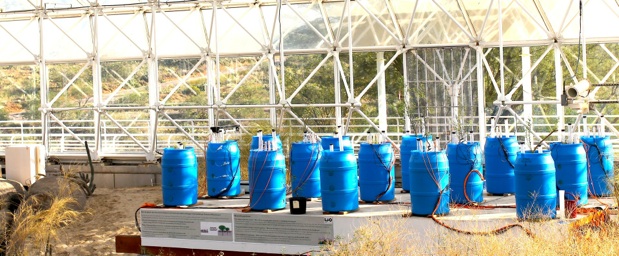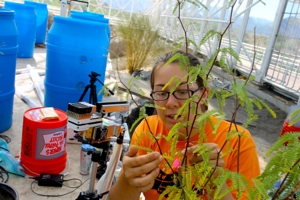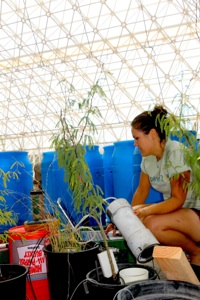Mesquite & Grass Mesocosm Experiment


The vegetative community of the semiarid southwest has been in a state of transition for the last 100+ years, as woody plants encroach into historic grasslands. This change in the dominant plants’ rooting depth and photosynthetic pathway leads to several important questions we address outside-the-glass of Biosphere 2 at a series of ecosystem-scale research sites:
-
*What do these changes mean for regional patterns of carbon sequestration over the short and longer term?
-
*How does these different growth forms differ in their responses to climatic changes of warmer temperatures, more variable precipitation, and more frequent drought?
-
*How coupled are belowground processes to aboveground plant function in these two species?
However, that work is often complicated by a lack of control of the very environmental conditions we are measuring plant and soil responses to. Also, as we work to inform ecosystem models about plant and soil microhabitat responses to climatic variables, we have aimed to isolate those plant-scale responses.
2. A hands-on scientific learning site for REU students
Many participants from the Research Experiences for Undergraduates (REU) program based out of Biosphere 2 were able work on this experiment and learn not only about measurements within their field of choice, but also experience integrated science. Professors with foci Ecology, Biochemistry, Soil Science, Geoscience, and Plant-Atmosphere science, Trace-gas production have all joined forces to address these central questions. The REU program gave the students a chance to build (and rebuild, see below) an experiment from the early stages, conduct a range of measurements, and produce posters demonstrating their work.
3. A prototype for the Landscape Evolution Observatory All of the sensors, techniques, and tools used within this mesocosm experiment will potentially be deployed within a mega-experiment being launched at Biosphere 2 in the coming year. The Landscape Evolution Observatory will be a series of large hillslopes that are heavily instrumented to track the movement of water through these landscapes and examine the influence of that water on localized biogeochemistry. While we do not know what type of vegetation will cover those hillslopes, using these regionally important plants will shed insights into the influence of shallow vs. deeper-rooted plants, woody vs. herbaceous plants, and stress-tolerant vs. intolerant species.
We’ve identified a lot of challenges in working with some of the potential instruments and techniques (you can see a great blog by B2 Science Writer Paul Ingram), so having a prototype where we can experience a problem at the 900-lb scale of a mesocosm pot that can be rebuilt vs. a 2,000,000-lb hillslope that cannot be rebuilt has been very helpful. Check-out the LEO website and associated blog for more details on that grand experiment.
Click here to access lead-scientist Greg Barron-Gafford’s webpage.
Click here to return to the Landscape Evolution Observatory webpage.
One project, many goals:
A large-scale pot experiment to study the effects of vegetation change on carbon and water dynamics, soil formation and evolution, and nutrient cycling

-
1.Opportunistic research within the highly-controlled
environments of Biosphere 2







-
*Sensors constantly log soil moisture, temperature, water potential, and CO2 concentrations at four depths within the soil.
-
*We couple these continuous measurements with weekly measures of root development, plant physiology, and soil respiration.

Shipherd Reed, UA College of Science Digital Media Producer, and crew produced the video above showing the installation of the Mesocosm experiment and a hint of the fun had by all of the REU students. Kelly Sykora (bottom left) measures mesquite photosynthetic rates, while Pin Pravalprukskul (bottom right) measures soil respiration from root-free incubations of soil from the mesocosm project.
